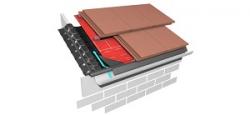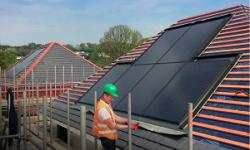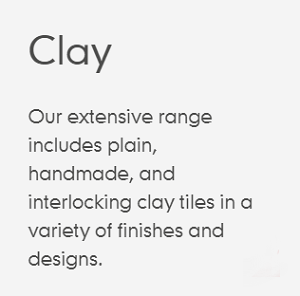MARLEY LTD
Suppliers of: Roof Tiles & Slates, Roofing Accessories, Cedar Shingles, Rafters, Decking, Integrated PV Photovoltaic Panels for Pitched Roofs.
Marley Range of Roofing Products & Systems
Marley is at the forefront of the roofing industry in the UK, with over 100 years of roofing expertise and heritage. We are the only UK manufacturer offering all elements of a roofing system including: Clay and concrete tiles, Shingles, Roofing accessories and BS 5534 compliant JB Red Batten.
Our complete pitched roofing solution comes with an unrivalled 15 year guarantee, offering you complete peace of mind. Our innovative and market-leading products also include a range of TDCA approved timber decking, which have been awarded the ’DeckMark’ accreditation.
All our products are supported by a wide range of easily accessible technical services and expert support for customers from all areas of the construction industry. We offer flexible, efficient service that saves our customers time and money on their projects and we’re even accredited by the Institute of Customer Service for our commitment to delivering the best possible customer experience. So whatever you need, we’re confident that we can provide the right solution and our online portal makes it quick and easy to get in touch with us.
Marley Roof Coverings
Marley SolarTile® roof-integrated solar tiles:
Marley SolarTile® is a roof-integrated solar panel solution, enhancing roof system specification with design flexibility, sleek aesthetics, industry leading wind and fire performance while acting as both a roof covering and electricity generating solution.
Clay Roof Tiles:
Marley offer a wide range of Clay roof Tiles and Accessories for all types of pitched roof construction
Concrete Roof Tiles:
Marley manufacture an extensive range of Concrete Roof Tiles and Accessories for all types of roof construction
Shingles & Shakes:
Marley offer a range of Western Red Cedar Shingles & Shakes which are fully sustainable and treated for durability
Roofing Base Layers
JB Red Batterns:
All JB Red roofing battens are supplied graded to meet the performance requirements of BS 5534.
Roofing Underlays:
Marley offer a wide range of roofing underlays, membranes and Accessories for all types of roof construction.
Roofing Finishes & Accessories
From Eaves Vents to Ridge Gullies, Marley offer an extensive range of Roof Finishes and Accessories for all types of roof construction.
Marley Decking
Marley also supply a wide range of Decking Systems including Anti-Slip premium decking available in assorted sizes for all types of Decking Specifications.
Further Technical information is available to download from the BPi Products Library or from the Manufacturer’s own website
Launch of the fully revised British Standard BS 5250
 The launch of the fully revised British Standard, BS 5250, aims to address all sources of moisture within buildings and the associated impacts to the building fabric and occupants’ health by preventing them from becoming breeding grounds for health hazards such as mould spores and spreading infections.
The launch of the fully revised British Standard, BS 5250, aims to address all sources of moisture within buildings and the associated impacts to the building fabric and occupants’ health by preventing them from becoming breeding grounds for health hazards such as mould spores and spreading infections.
BS 5250:2021 replaces BS 5250:2011 + A1 2016 and gives new guidance on preventing moisture risk in buildings, including pitched roofs. The revised Standard was launched on 29 July and has been re-named ‘Management of Moisture in Buildings – Code of Practice’ to reflect its new, integrated whole building approach, which considers the interactions between the fabric, services, and occupants.
While former editions of the Standard focussed mainly on condensation, the new guidance has been broadened to include other moisture problems such as excessive humidity, rising damp, rain penetration and roof leaks. It also recognises that, in both new and existing buildings, the gap between the design on paper and the way it performs when it is built and in use may vary significantly, particularly due to modern building methods and climate change.
The revised Standard represents best practice in terms of assessing, controlling, and preventing the risk of moisture in buildings, giving both design and practical recommendations.
Stuart Nicholson, roof systems director at Marley, explains: “The changes that are introduced in BS 5250 recognise the fact that buildings are coming under increasing stress from excess moisture, not only from climate change, with increasingly high rainfall and flooding risk, but also due to improved energy efficiency, causing greater humidity in buildings.
“We have been advising about the risks associated with moisture and the importance of adequate ventilation for many years now. The revised BS 5250 is an important step forward because it adopts a whole building approach to reducing the risk of excess moisture. Pitched roofing has a critical role to play in this integrated guidance and in the revised Standard, roofs are covered in greater depth than before and the different moisture risks between roof types are explained in detail. Importantly, it shows that roof ventilation should not be seen as an add on but is an important part of the whole building approach to managing moisture. This will help to prevent damage to buildings from different types of excess moisture and reduce the harmful risk to occupants’ health from inadequate ventilation levels.”
When designing pitched roofing, the natural movement of air within a building means there is a permanent risk of moisture laden air in the form of vapour, likely to ascend to the roof space. It is almost impossible to create an air-tight envelope, so specifications must provide minimum levels of ventilation to the roof void, in combination with a vapour permeable underlay and air open roof covering to ensure there is minimal risk of condensation within the roof build up.
When it comes to managing moisture in pitched roofs, much of the guidance from the previous BS 5250:2016 still applies. However, there are some changes in the revised Standard, including:
• Clearer advice on the use of high resistance and low resistance underlays, as well as air and vapour control layers, when used with air permeable and air impermeable roof coverings.
• New guidance on the calculation methods for assessing moisture risk in roofs in the form of a table relevant for ‘as designed in theory’ (ADT) and ‘as-built in service’ (ABS) conditions for various pitched, flat, and composite roof types.
• Designers are alerted to minimise the risk of surface condensation on the ceiling of any occupied spaces by ensuring that thermal insulation is continuous and that thermal bridging at roof / wall junctions and around openings is minimised.
• Design considerations should now take account of internal finishes and ceilings, particularly the importance of maintaining air tightness to prevent the transfer of most air into colder roof voids.
• More focus on the importance of sealing openings and minimising thermal bridging at the eaves.
Stuart Nicholson adds: “It is important all roofing specifications are reviewed to make sure they are in line with the new guidance and calculation methods. If in doubt, specifiers can contact our technical team who can provide advice and full roof system specifications to ensure correct ventilation levels and reduce moisture risk.”
Read our in depth review of BS 5250 via our website at: https://www.marley.co.uk/blog/launch-of-the-fully-revised-british-standard-bs-5250
The path to net zero starts up on the roof
 As social housing landlords grapple with decarbonisation, the need to invest in the right technology is vital. Big decisions made now are likely to have long-term implications. But with the government still to fully outline the best technologies to make homes more energy efficient, landlords are faced with the quandary of which systems to invest in. They have to balance their journey to net zero with ensuring they don’t make costly mistakes that could catch up with them down the line. With changes to Part L of the building regulations coming in next year that will affect all new build homes, Inside Housing spoke to Stuart Nicholson, roof systems director at Marley, the roofing manufacturer.
As social housing landlords grapple with decarbonisation, the need to invest in the right technology is vital. Big decisions made now are likely to have long-term implications. But with the government still to fully outline the best technologies to make homes more energy efficient, landlords are faced with the quandary of which systems to invest in. They have to balance their journey to net zero with ensuring they don’t make costly mistakes that could catch up with them down the line. With changes to Part L of the building regulations coming in next year that will affect all new build homes, Inside Housing spoke to Stuart Nicholson, roof systems director at Marley, the roofing manufacturer.
With the changes to building regulations in England, what should housing associations think about?
They’re going to have to incorporate energy-saving technologies when they are building new homes. They can use any technology, and there are lots available, but one of the easiest and most cost-effective routes would be to use solar photovoltaic (PV) systems. As well as being cost-effective, solar panels are readily available and a known technology. It’s the path of least resistance to adhere to the new Part L regulations.
Scotland introduced rules around carbon reduction in new homes in 2016. What has been its experience?
It’s been a game-changer for the use of solar panels in Scotland. In 2016, around 10% of new builds had solar panels, but last year this figure was 70%. There’s no reason why this shouldn’t be the same experience when the rules change in England.
The changes to Part L only affect new builds, so what should landlords consider in terms of retrofitting or planned maintenance in relation to decarbonisation?
The cost of repairing a roof is almost as much as replacing it. If you’ve got planned maintenance and you’re replacing a roof, you need to look at incorporating solar panels. It should be the first thingthat you think about: “How can we get the most value from that roof?” By installing solar panels, it will give you that no-regrets future-proofing for a property, and then you can look at adding additional technologies.
The government aims to install 600,000 heat pumps a year by 2028. How do solar panels fit into that?
We would encourage any social landlord looking to put a heat pump in to think about how it is going to be powered. Solar panels are often used to help run the heat pump. A heat pump on its own could potentially put tenants into deeper fuel poverty if that’s the only source of heat. It’s completely different to what they’re used to and runs solely on electricity. We’ve seen cases where tenants got a heat pump and then still went out and bought electric heaters because they wanted a quick burst of heat when they felt cold. That’s using more electricity and creating additional costs. Although there are many benefits to heat pumps, there’s a lot of capital cost, too – for example, you need a whole new radiator system for them to work properly and the house needs to be well insulated. But heat pumps and solar panels are two very good bedfellows. In our view, you shouldn’t be installing heat pumps without solar panels as well. Afterthoughts tend to cost a lot more money, so make all the considerations at the start of your project.
What are some of the advancements in solar panels?
One of the big ones is solar panels becoming integrated. With integrated solar panels you have a much better, cleaner aesthetic and it’s part of the roof covering, so there’s very little maintenance. The only thing that may be needed is cleaning, but with integrated panels, there’s less likelihood of mess from birds than with bolt-on panels. The raised nature of bolt-on panels gives birds a perfect nesting spot; they often perch on the panel, creating a lot of mess across the roof. The cost has fallen dramatically on solar panels, too, and the power they generate is increasing all the time. When we were installing solar panels back in 2010, they were probably 200 watts or 220 watts peak per panel. Now, for the same size panel, we’re seeing 50% more power out of the same area. We will probably see the energy increase further on panels in the future. A technology that’s widely used to help improve the benefits of solar for the tenant is a PV power diverter, which detects when you’re generating more electricity than you can use and will switch something on in the house. The ‘something’ is often an immersion heater in a hot water tank. So you’re keeping that electricity in the house, and you’re using it to heat up water that you can use in the evening. That’s a really cheap addition to a PV system that enhances the benefit to the tenant. Battery storage is getting a lot more attention too, although it’s still rather pricey and tends to be used more in demonstration projects at the moment.
What has been your experience of how tenants have responded to solar panels?
Our feedback from tenants has been really good, especially as the use of solar panels has increased and people have become more aware of them. The introduction of integrated panels seems to have had a big impact on tenants’ views, as they become a seamless part of the roof and give a good aesthetic finish. Tenants, like other members of the public, are more aware of what’s happening with regard to climate change and energy usage. Tenants not only feel that they’re saving money, but also that they’re having a positive impact on the world around them. It’s important to remember that however small the array of solar panels, it should still save energy for the tenant. Even a small number of appliances using electricity in the background, like things on standby or fridges, can use the electricity that is produced. Every penny saved will help a tenant on low income or affected by fuel poverty.
What do you say to anyone who is worried that solar panels are not suitable for the UK climate?
It’s not heat that solar panels are using, it’s light. The hotter panels get, the less efficient they are, so the UK climate is as good a place as any. They don’t generate quite as much on cloudy days, but they still generate a good amount of electricity.
What would be your overall message to social landlords?
I think the biggest takeaway is just thinking about the planned maintenance and assessing all their housing stock. It may be that they don’t need to rush out and look at putting renewables in everything now. But there could be an opportunity for them to save money by planning it in line with their reroofing schemes. As with any maintenance, the expensive aspect is access and labour, so utilising that to incorporate renewable technologies while making housing upgrades is something to consider, and may save time and money in the long run.





